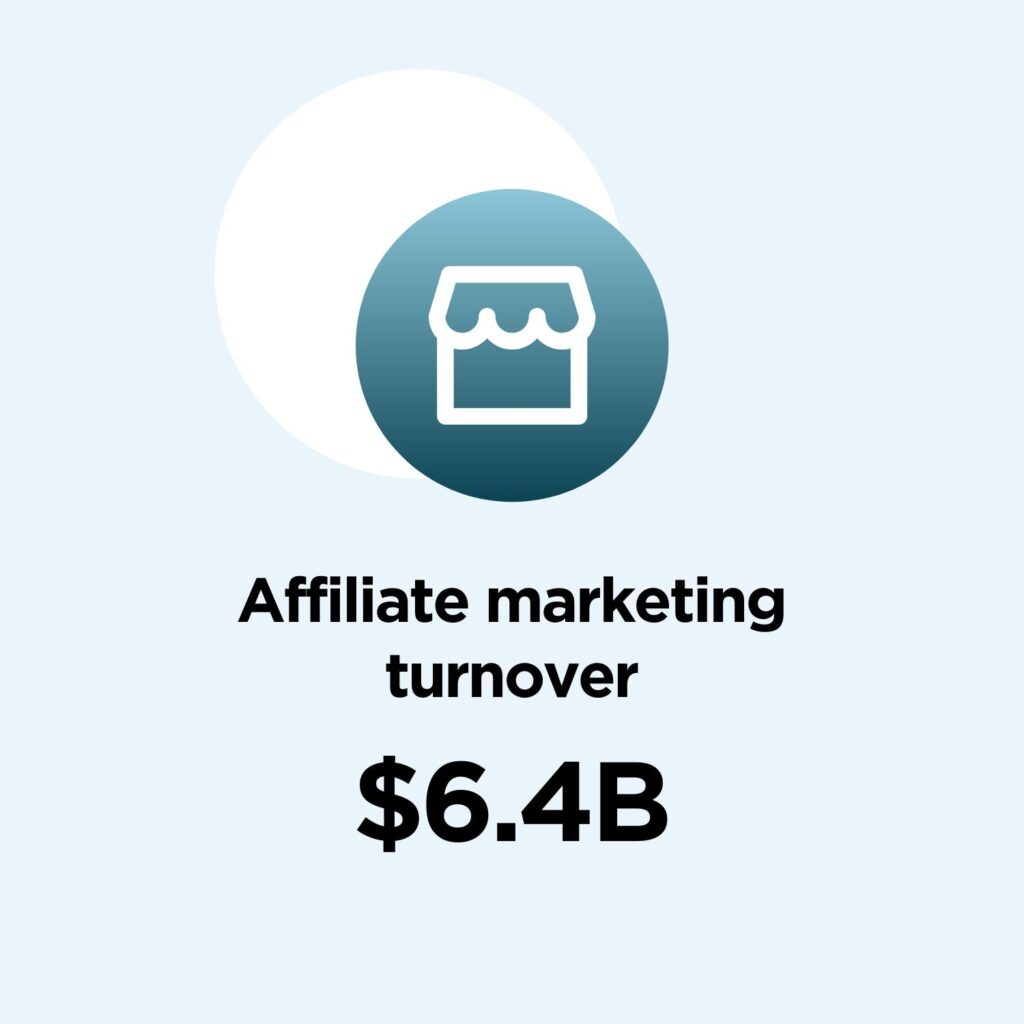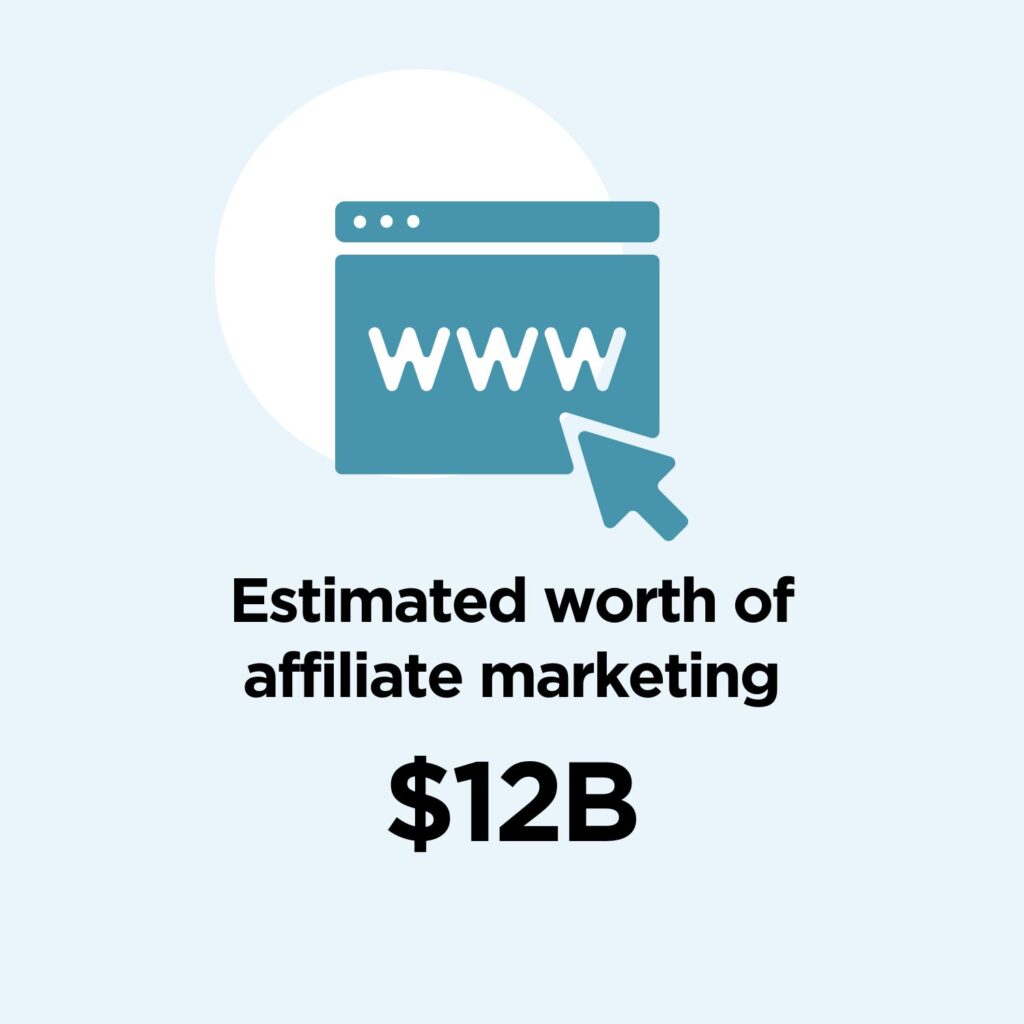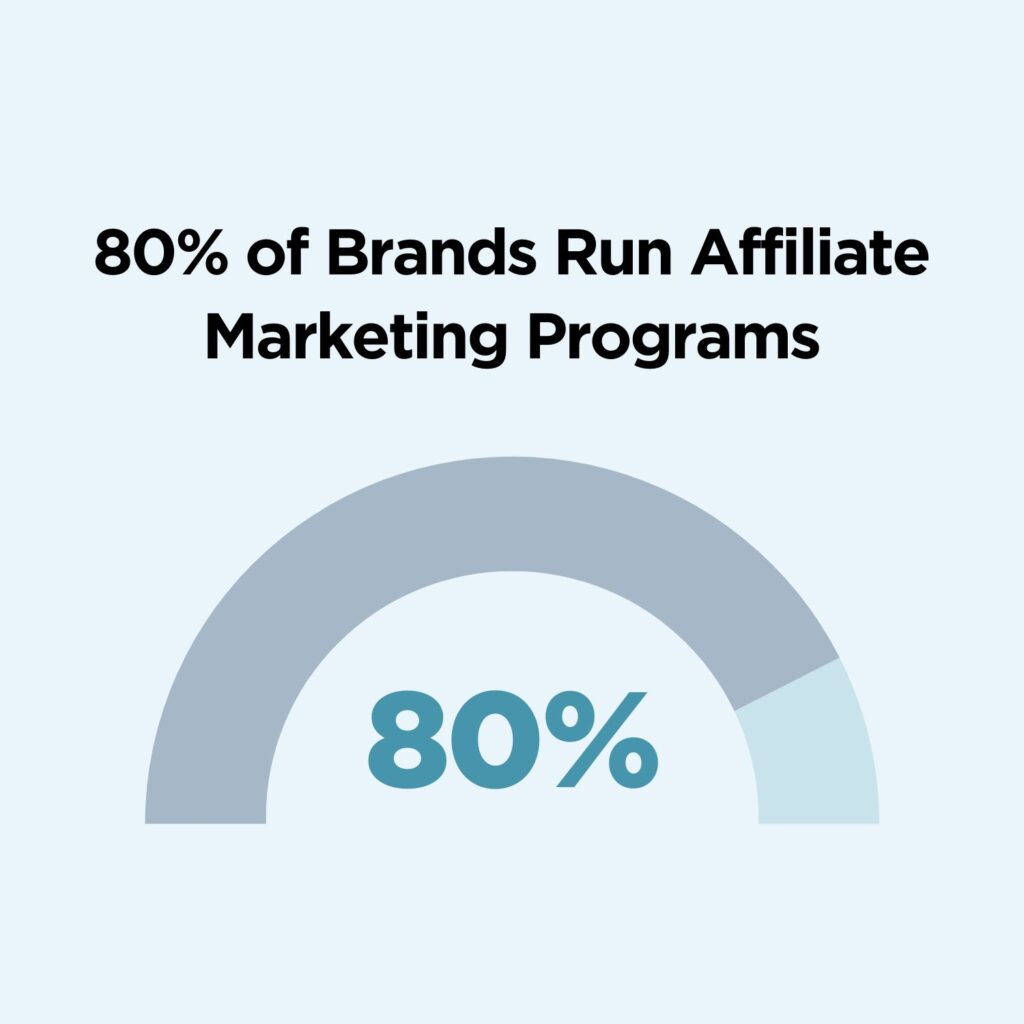What are the top affiliate marketing statistics?
Here, we’ve aggregated a robust list of 41 research-backed statistics all about affiliate marketing from verified sources. Read on to learn the top affiliate stats, industry growth figures, facts about affiliate marketing trends, and so much more.
Ready to get into it? Here we go!
Top affiliate marketing statistics in 2024
- Over 80% of brands use affiliate marketing programs
- Affiliate marketing is a $12 billion industry worldwide
- Affiliate marketing spending is growing over 10% year over year
- 15% of the digital media industry’s revenue comes from affiliate marketing
- 16% of eCommerce sales in the US and Canada are generated through affiliate marketing
- Over 69% of affiliate marketers claim SEO drives the most traffic to them
- Affiliate marketing is the top acquisition channel for 40% of US merchants
- 40% of online marketers consider affiliate marketing as a critical skill
- 50% of all affiliate traffic comes from mobile devices
- 79% of marketers use affiliate marketing to engage existing customers
What is affiliate marketing?
Affiliate marketing is the marketing strategy where an online retailer pays a commission out to another for helping generate sales, referrals or website traffic. It’s like word of mouth marketing but affiliates paid when they successfully convert someone, therefore giving them an incentive to advertise a certain product, service or brand.
An “affiliate” is a person or a company that earns commissions through their efforts. Common affiliates are social media influencers, bloggers or blogs, and even newsletters or websites. Essentially, anyone with a following can begin affiliate marketing and has the potential to be successful.
As you’ll soon learn, companies love affiliate marketing. Why? Because advertisers only pay out commissions when an affiliate converts. Affiliate marketing is a smart sales cycle that’s financially beneficial to the company—and the affiliate. It’s a win-win!
Now that you have some background, let’s get into the real affiliate marketing statistics.
Affiliate marketing growth statistics
1. U.S. affiliate market spending is expected to hit $8.2B
(Statista)
Affiliate marketing spending has steadily increased year over year since 2010 meaning more companies are getting involved and investing more into this marketing strategy. Reaching over $8B, the amount spent on affiliate marketing has more than doubled since 2017 ($5.4B increase). In 2021, it was $7.4B.
2. In 2019, affiliate marketing reached $6.4 billion in turnover.
(eMarketer)
The revenue from affiliate marketing is on the rise every year. In 2019, turnover from affiliate marketing reached $6.4 billion. In fact, reports show that since 2015, revenues have jumped 52%.

3. Affiliate marketing spending is growing over 10% year over year
(eMarketer)
At the same time, the spend on affiliate marketing has increased at an annual rate of 10%, with retailers accounting for 25%.
4. 65% of B2C marketing executives predicted they would spend more on affiliate marketing in 2021 (and they did)
(eMarketer)
Amid the pandemic in 2021, marketing executives sensed a big change was coming for marketing budgets. 78% thought both the spend on digital advertising and social media marketing would increase. 65% predicted that they would spend more on partnership, aka affiliate, marketing.
5. Affiliate marketing spend is increasing at a rate of 27% CAGR
(BloggingX)
Just as the previously mentioned marketing professionals predicted, the annual spend on affiliate marketing is growing each year. At a 27% compound annual growth rate, the spend on affiliate marketing isn’t slowing down anytime soon.
6. The search volume for keyword “affiliate marketing” grew by 100%
(Influencer Marketing Hub)
More and more people are getting curious. According to Google Trends, the keyword search for “affiliate marketing” worldwide has increased every year for the past five years. The search term peaked by growing 100% in June 2021. Why? Experts say it’s due to the growth of eCommerce businesses as they move away from traditional store fronts and look to sell more online.
What is the affiliate marketing industry worth in 2023?
7. This year, affiliate marketing has an estimated worth of $12B globally
(Influencer Marketing Hub)
Affiliate marketing has secured its place as a multi-billion dollar global industry. The industry is worth an estimated $12B and is projected to continue growing each year. That figure is three times what affiliate marketing was worth in 2015.

8. 31% of US brands listed affiliate marketing within their top 3 revenue sources in 2021
(eMarketer)
As even more US companies worked to expand their online sales after the pandemic, 31% of survey respondents said eCommerce would be their top revenue source in 2021. Almost one-third said affiliate marketing was one of their top three revenue earners. 9% predicted affiliate marketing would be their top revenue earning source.
9. 15% of the digital media industry’s revenue comes from affiliate marketing
(Business Insider)
A big chunk of the digital media industry’s revenue comes from affiliate marketing, while it traditionally has relied heavily on advertising. An increasing number of publishers are integrating product links in organic content.
10. The global digital advertising market is expected to be worth over $763B in 2025
(BusinessWire)
Digital advertising includes everything from search engines to affiliate programs. This giant market is valuable because digital ads can reach the right people with the right message at the right time—something traditional marketing methods could not. So, in 2020 the digital advertising market reached $374B with a compound annual growth rate of 15.7% since 2015. For the next few years, experts expect the CAGR to stay consistent at 15.3%, so the global digital advertising market will be worth over $1,449B in 2030.
Affiliate marketing trends
11. 80% of or 8 out of 10 brands run an affiliate marketing program
(Rakuten’s Forrester Report)
Based on a study a few years ago, 8 out of 10 brands and 84% of publishers run an affiliate marketing program. They do so in order to “improve website traffic and increase sales.” Of those surveyed, 80% reported that they dedicate 10% of their overall marketing budget strictly to affiliate marketing.

12. Affiliate marketing is considered a “crucial skill” by 40% of online marketers
(BloggingX)
Nowadays, it is almost necessary to have experience with affiliate marketing if one plans to pursue a career in digital marketing. This is shown by the fact that 81% of brands rely on affiliate programs to improve their business. On top of that, 90% of advertisers consider it important to their digital marketing strategy.
13. 83% of affiliate marketers target consumers during the discovery and awareness phase
(Rakuten’s Forrester Report)
Affiliate marketing is not just used at one stage of the customer funnel. Instead, it’s a full-funnel strategy. While 83% target those discovering the brand, 79% target potential buyers during the conversion or purchasing phase.
14. 79% of marketers use affiliate marketing to engage existing customers
(Rakuten’s Forrester Report)
In addition, affiliate marketing is used to strengthen brand sentiment. 79% of marketers use affiliate marketing to maintain ongoing customer engagement long term.
15. Almost 60% of brands used influencers for affiliate campaigns
(The State of Influencer Marketing Report)
Affiliate marketing isn’t just for affiliate networks considering 59% enlist the help–and klout— of influencers. Influencers are natural affiliate marketers since they already foster a loyal following. The other types of influencer categories used for affiliate campaigns included bloggers (28%), review sites (19%), coupon sites (15%), newsletters (7%), editorial sites (6.5%) and “other” (23%).
| Campaign type | Percentage |
| Bloggers | 28% |
| Review sites | 19% |
| Coupon sites | 15% |
| Newsletters | 7% |
| Editorial sites | 6.5% |
| Other | 23% |
16. Over 69% of affiliate marketers credit SEO as their top traffic source
(BloggingX)
Where do affiliate marketers source the most leads that earn a commission? The top traffic source that affiliates credit is SEO at 69%, followed by social media at 67%. Writing content like blogs produces 65% of traffic while email marketing attracts 42%. PPC campaigns produce just over one-third (34%) of reported traffic.
| Traffic source | Percentage |
| SEO | 69% |
| Social media | 67% |
| Content | 65% |
| Email marketing | 42% |
| PPC | 34% |
17. 50% of affiliate traffic comes from mobile devices
(BloggingX)
Where are people clicking on affiliate links? Well, half of affiliate traffic comes from mobile devices. That means people are showing interest in promoted products or services on the go. This affiliate marketing statistic shows how important mobile ads are as even more people are beginning to do more on their phones (browse social media, check email, read blogs, etc.). Of affiliate marketers, 80% track their desktop and mobile sales.
18. Bloggers earn a 40% share of publisher commissions
(Awin Report)
Within the United States, bloggers have proved that content is king. Bloggers and blogging sites earned the lion’s share of the commission market with 40%. Other notable publisher types that earned commissions were cashback and rewards sites, or coupon and voucher sites.
19. 65% of affiliates use social media to engage with potential customers
(Affstat Report)
Social media is a pillar for brand awareness, but it is also a huge channel for affiliate marketers. 65% of affiliate marketers report using social media to promote their commission-worthy products and services. Social media is a natural channel considering 67% of affiliates already used top platforms like Instagram, Facebook, and Twitter to grow and connect with their own audiences. With affiliate marketing, they can now monetize their followers.
20. Over 82% of affiliates promote B2C products and services
(Affstat)
The 2016 report may be a few years old, but it is reasonable to imagine today’s metrics are similar. Affstat discovered that the vast majority of affiliates are working in the B2C sector. Almost 60% sell B2C products and 22% promote B2C services. Only 18.6% of affiliate marketers work in the B2B space. Just 12% sell B2B products and only 6% sell B2B services.
21. Over half of all affiliate marketers are male
(Influencer Marketing Hub)
If you’re curious who affiliate marketers are, 54% are male while 43% are female. However, experts predict the rise of more female content creators will sway this statistic soon. Of these, 55% are married, 33% are single and less than 10% are divorced.
22. Most affiliate marketers are between 35 and 44 years old
(Affstat)
The majority of affiliate marketers are within the age range of 35-44 (32%). The next largest group is 25 to 34-year-olds (28%). Only 3% are over 65 years old and less than 0.3% are under the age of 18.
23. Almost 55% of affiliate marketers work from home
(Affstat)
Over half of all affiliate marketers work from home. However, 26% said that they work both at an office/place of work and at home, it just depends on the day. Less then 20% commute normally to an office according to affiliate marketing statistics.
Affiliate network trends
24. Amazon has over 900,000 active affiliates within its network
(Supermetrics)
The world’s largest affiliate networks have well over 100,000+ affiliates. The largest is Amazon with almost one million. ShareASale is in second place with over 700,000, then Awin with 205,000. ClickBank, and a few others, have over 100,000 affiliates in their network.
25. Amazon has a 46% market share of companies using their affiliate program
(Datanyze)
With 86,516 companies using Amazon’s affiliate network technology, they control the market share at 46.11%. CJ Affiliate is second at 8.16% and a directory of 15,255 companies. Rakuten’s Affiliate Network has 7.62% of the market share with a little over 14,000 companies leveraging their technologies.
26. The global market size of the Affiliate Networks industry is over 100k companies
(Datanyze)
According to Datanyze, there are 107,179 companies worldwide making up the Affiliate Networks industry. Of those, 55 companies are producing Affiliate Networks’ different technologies.
27. 83% of brands and publishers recruit new affiliates via network dashboards
(Rakuten’s Forrester Report)
If you’re wondering how brands find affiliates to join their programs, an impressive 83% find them through the help of an affiliate network and 79% find them by attending events hosted by affiliate networks. Meanwhile, 71% recruit affiliates with a simple “Join Network” button on their websites and 56% host their own recruiting events.
28. 71% of publishers belong to 3 or more affiliate networks
(Rakuten’s Forrester Report)
An overwhelming 96% of publishers belong to more than 2 networks. Only 4% of publishers reported that they only work with one. A surprising 20% of brands work with 5 or more networks, while some work with two (23%), three (39%) or four (12%). Why do publishers work with multiple networks? It’s based on numerous factors like what competitors are on the platform, which brands they can connect to, and more.
What is the average revenue from affiliate marketing?
29. Affiliate publishers earn an average of $51,000 each year
(Influencer Marketing Hub)
What percent of affiliate marketers are profitable? Well, the largest group of publishers, 18.8%, earn less than $20k annually, but the other 80+% are making decent profits. The next 20% earn between $20-80k each year. A lucky, or maybe hard-working, 6% reportedly earn over $2M per year from affiliate marketing. Publishers say that affiliate marketing creates an opportunity to earn money with little effort.
30. Commissions usually range from $3-$200, or 1% to 60% per sale
(Influencer Marketing Hub)
Of course, these figures depend on the niche and item being sold. This is a cost per sale payment method where affiliates earn a fixed amount or a percentage of the cost of the item. Some affiliates can earn thousands per sale, but its not the norm.
However, the most common way that affiliates are paid out is cost per action, also known as pay per lead. That means there is a flat rate for each set action (ex. email sign-up, event registration, etc.) that a customer takes to be considered a conversion.
31. Affiliate marketing efforts have a conversion rate of around 1%
(Influencer Marketing Hub)
One case study depicted affiliate marketing conversion rates are between 0.5% and 1%. Conversion rates vary greatly from industry to industry, and the majority of affiliates don’t offer to share their conversion rate, so this affiliate marketing statistic is tough to gather accurately.
32. Bluehost, a web hosting platform, paid over $5M in commissions
(Influencer Marketing Hub)
Web hosting is one of the most popular—and most lucrative—things to sell as an affiliate marketer. Thanks to the rise of people starting their own blogs or businesses, more people are launching websites than ever. Bluehost offers one of the highest-paying programs, earning affiliates between $65 and $130 per sale.
33. Health and wellness is the most profitable niche in affiliate marketing
(Influencer Marketing Hub)
Worth over $4 trillion, the health and wellness industries are considered the most profitable niche to enter. The fashion industry makes up about 25% of all affiliate program accounts. Other popular niches include hobbies, travel, gaming, technology, sports, personal finance, and pet care.
34. 41% of affiliates promote computer and electronics
(Affstat)
Almost half of affiliate marketers are earning commissions from referring products in the computer and electronics category. Other top categories are clothing/apparel (40%), online services (30%), accessories (29%), and beauty (28%). The least popular categories are military products or services (2%), legal (3%), non-profit (3%), and insurance (4%).
What is the success rate of affiliate marketing?
35. 33% of US directors think affiliate marketing programs are “highly successful”
(Forrester)
In total, 42% say that their affiliate programs are successful, and one-third claim it to be highly successful. The next 20% considered it somewhat successful. Only 5% of US marketing directors said that their attempted affiliate programs turned out to be not successful.
36. Over 50% of publishers use network-provided reporting platforms to help manage their affiliate programs
(Rakuten’s Forrester Report)
One reason that affiliate marketing programs may have a higher success rate than other marketing channels is that over half of brands with an affiliate program use a network platform to help. A network-provided reporting platform is an effective tool to manage efforts, recruit new affiliates, handle commission payouts, and gain analytical insights.
37. 20% of marketing directors think affiliate marketing is the most important channel for their organization’s customer acquisition
(Forrester)
Over half (54%) of these survey respondents listed affiliate marketing as one of their top 3 channels. Other top channels listed as the most important for acquiring new customers was paid social (12%), display ads (15%), paid and organic search (16%), and PR and influencer marketing (11%).
38. Groupon made over $1B in revenue in 2020, thanks to its affiliates
(Statista)
The worldwide website, Groupon, has a business model built upon affiliate commissions as it connects subscribers with local merchants. In 2020, the company’s annual revenue topped $1.4B, even during a pandemic. The year before in 2019, Groupon’s annual revenue was over $2.2B.
39. 16% of all eCommerce sales in the US and Canada are generated by affiliate marketing
(Business Insider)
That is a lot of commission-earning clicks. In 2017, affiliate marketing generated 5 billion clicks worldwide. That number attributed to 16% of all eCommerce sales in North America.
40. Publishers claim that affiliate partnerships drive over 20% of their annual revenue
(Inc.)
Alongside this statistic, 40% of US retailers said their leading customer acquisition channel was affiliate programs. Between 2015 and 2020, the US is expected to spend more and more on affiliate marketing, increasing by a CAGR of 10.1%.
41. Almost two-thirds of merchants think affiliate marketing meets their revenue expectations
(Fetch Profits)
In conclusion, affiliate marketing works for many companies—big or small. 73% of merchants reported their affiliate revenue satisfied their expectations. So, it’s no surprise to learn that 91% of all merchants effectively plan their affiliate marketing budgets.
Frequently asked questions (FAQ)
How big of an industry is affiliate marketing?
Affiliate marketing is a $12 billion industry. In the US alone, affiliate marketing spending is over $8 billion.
Is affiliate marketing worth it?
33% of executives say that affiliate marketing is “highly successful.” 42% say their programs are successful, 20% consider them somewhat successful, and 5% say they’re not at all successful.
Over to you!
There you have it! You just read 41 affiliate marketing statistics to gain a better understanding of this interesting and rapidly growing industry.
Want to learn more about the top online marketing strategies?
Sources:
The State of Influencer Marketing Report
Further reading:
The Ultimate List of Side Hustle Statistics




